HP Stream 11 Review: A New Take On Low Cost Computing
by Brett Howse on December 17, 2014 8:00 AM ESTDisplay
The rise of smartphones and tablets has dramatically changed the display landscape, with practically all tablets having In Plane Switching (IPS) displays. IPS offers much better viewing angles and color reproduction compared to the standard laptop displays that use a Twisted Nematic (TN) based LCD. There has been the start of a push to IPS panels on notebooks, but far too many are still burdened with TN. The lower the cost of the device, the higher the probability it will have a TN panel - Chromebooks included. The HP Stream is one of the lowest priced notebooks available and as such, it is saddled with a TN LCD, and not a very good one at that. But, with the price point it has achieved, we must set our sights a bit lower.
With a resolution of 1366x768, the HP Stream 11 has the standard “HD” resolution and 16:9 aspect ratio of almost all notebooks under $500, and once again with this price we should not be shocked or outraged. Compromises must happen to reach lower prices, and the display is almost always one of the first to go. With the 11.6” diagonal dimension, this display comes in at 135 pixels per inch, which is actually higher than the standard 96 DPI Windows was founded on. It is not high DPI by any means, but it is what is expected at this price point.
With a fairly low resolution, there is no need for any sort of strange pixel arrangement, and as such we have a standard RGB stripe. The display has a matte finish, which causes some subpixel distortion.
To evaluate our displays, we utilize a custom workflow in SpectraCal’s CalMAN 5 software. To measure brightness and black levels, an i1Display Pro from X-Rite is used, and for color testing the X-Rite i1Pro spectrophotometer is leveraged.
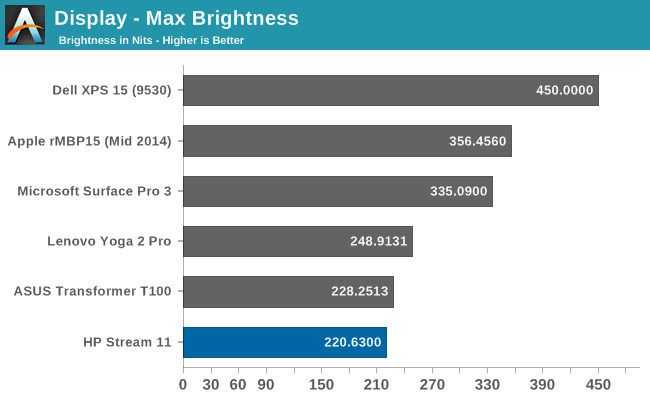
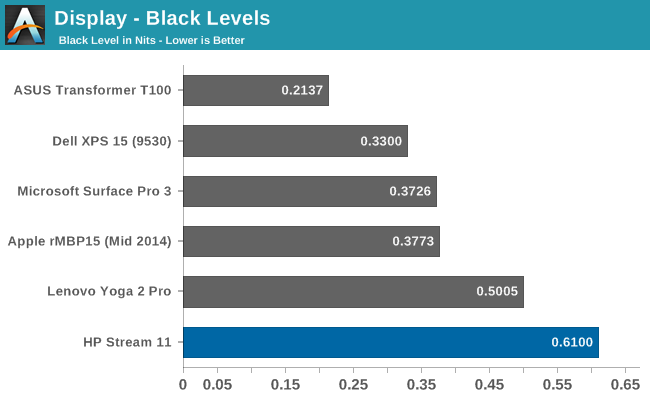
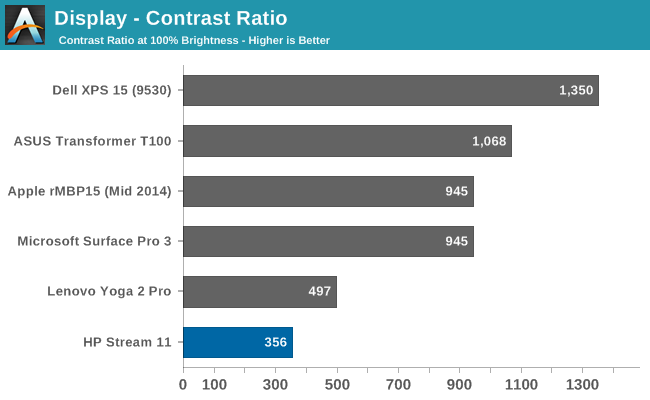
The HP Stream 11 is not a very bright display, but at 220 nits it is fine for indoor use. The matte finish would help somewhat for outdoor viewing, but would still make for a poor experience. High black levels result in a very poor 356:1 contrast ratio, which is further hampered by the poor viewing angles of the TN TFT.

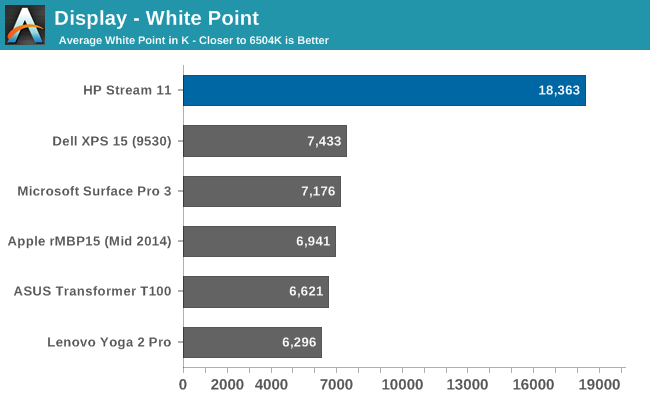
As you can see in the image, the blues in this display are ridiculously high, and the reds drop to nothing. This gives an absurd uncalibrated white point of 18363, when it should be as close to 6504 as possible. The grayscale accuracy is also far too high at 11.6.
When we perform our testing, we are targeting sRGB which is the standard color space for most web content. The HP Stream is not even close to the entire sRGB space, and the amount of drift on our saturation sweeps is very severe. The 100% blue and 100% red are both closer to the 80% mark than the 80% is, which makes the magenta very shifted and compressed. The overall score of 12.01 is very poor.
The colorchecker only confirms the bad news, with an overall score of 10.5. This panel is really poor. Not much more can be said. Calibration also did nothing for the display. It is difficult to calibrate a display to a particular color space when it cannot do the entire gamut. To have a standard, we calibrate to sRGB at 200 nits, and while the Stream 11 is bright enough for this, the LEDs are at practically maximum brightness which likely makes these results even worse.
We have been spoiled by an influx of high quality displays on devices lately. The HP Stream 11 does not continue this trend. It has a TN LCD which is quite terrible, and harkens back to the days of old. At the same time, some leeway should be given due to the price point of the laptop. Clearly HP had a $199 price point in mind and had to find savings to hit that price, and the LCD is always one of the first things on the chopping block. Still, this is even a poor display by poor display standards.







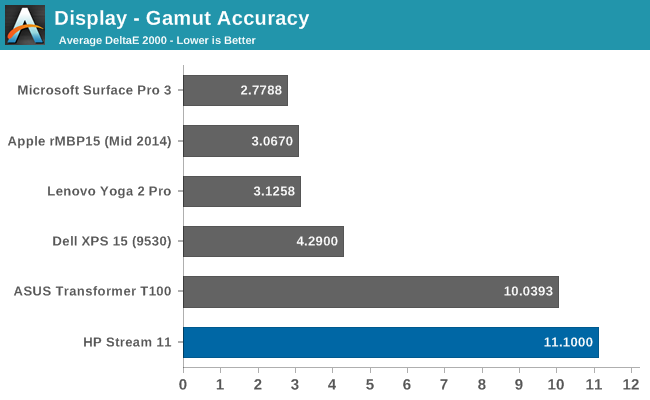








59 Comments
View All Comments
jabber - Wednesday, December 17, 2014 - link
If the user decides to start using the Office 365 and Onedrive for all their data and such then they will have to pay a year later to continue using such features.With not a lot of space I can assume the OneDrive will be very popular.
Folks don't think things through. They just see "$200!!!"
steven75 - Wednesday, December 17, 2014 - link
Wouldn't they just switch to a free competitor after the trial?jabber - Wednesday, December 17, 2014 - link
I tell customers about Libre Office and Open Office."Never heard of them!" is the same response I get every time. Average Joe hasn't a clue.
These machines are going to be pushing the use of Office big time so there will be a lot of moaning next year.
Going to be lots of moaning next year.
kyuu - Wednesday, December 17, 2014 - link
You don't have to pay for Onedrive storage. And I'm not aware of any platform where you get an Office license free in perpetuity, so the cost to use Office isn't any more than any other platform. If you don't care about using Office, you can use an alternative on the Stream just as well as on any other device. There is no extra $100 a year to use it.jospoortvliet - Saturday, December 20, 2014 - link
Google docs & drive are free, so is LibreOffice.Ms has to somehow keep shareholders happy who are used to insane, monopolist margins, let's see how that goes...
BrokenCrayons - Thursday, December 18, 2014 - link
LibreOffice is a fairly small install and something like a SanDisk Cruzer Fit in the 32-64GB range for under $35 for a one time purchase will solve both the office suite and storage capacity problem in a reasonable way. Those options may not be perfect for everyone, but they don't drive the total cost of ownership upward much and the thumb drive can be used on another computer later.I admit that I'm curious about how well a Linux distro would work on the Stream 11. Without worrying about touchscreen hardware, it might be possible to get something like Mint 17.1 on it which would give the user a little more storage space at the cost of losing access to the Windows software ecosystem. At this price point, its cheap enough to buy one just to play with using a live disc or USB boot to see how it works and if all the hardware is supported in a fairly painless way.
tidris769 - Thursday, December 18, 2014 - link
Mint 17.1 runs very well on my Aspire ES1-111M-C7DE, which has the same cpu/ram/screen. The Aspire does have a 250GB SATA disk instead of 32GB flash, so I have never been worried about storage space to begin with. The Aspire has been on sale for as little as $153 recently.BrokenCrayons - Friday, December 19, 2014 - link
Thanks! The Aspire actually looks like a better option because of storage space too. I think I might have to buy one. :)jsl4980 - Wednesday, December 17, 2014 - link
The Stream 11 is supposed to be a Chromebook competitor, but there's no Chromebooks in the comparison charts. I'd like to see how this stacks up agains similar priced Chromebooks in web and battery tests.Brett Howse - Wednesday, December 17, 2014 - link
We have not had any of the current Chromebooks in for review. The last that was reviewed was based on A15 ARM. Here's the performance of that one though if you are interested: http://home.anandtech.com/show/7418/hp-chromebook-...